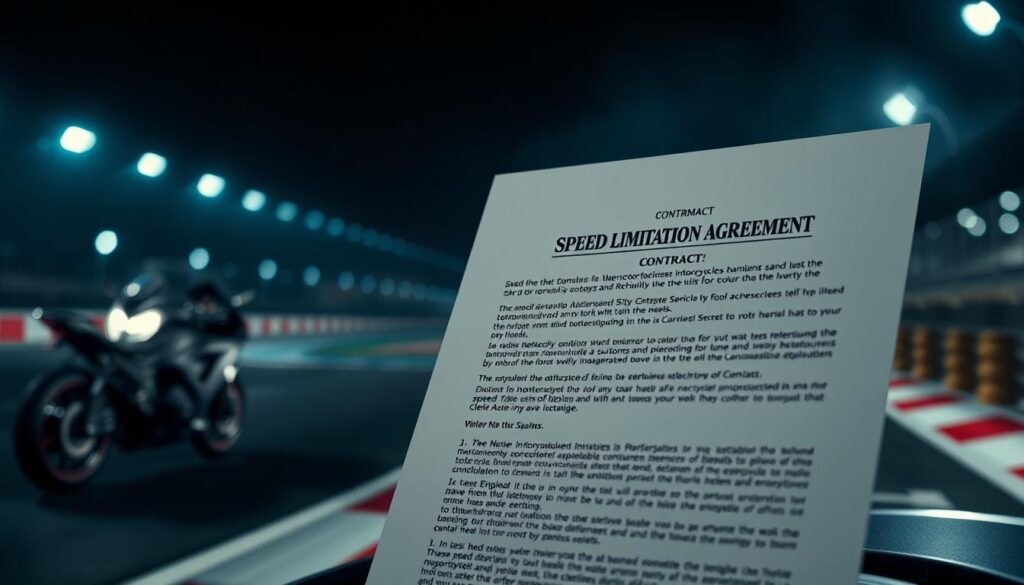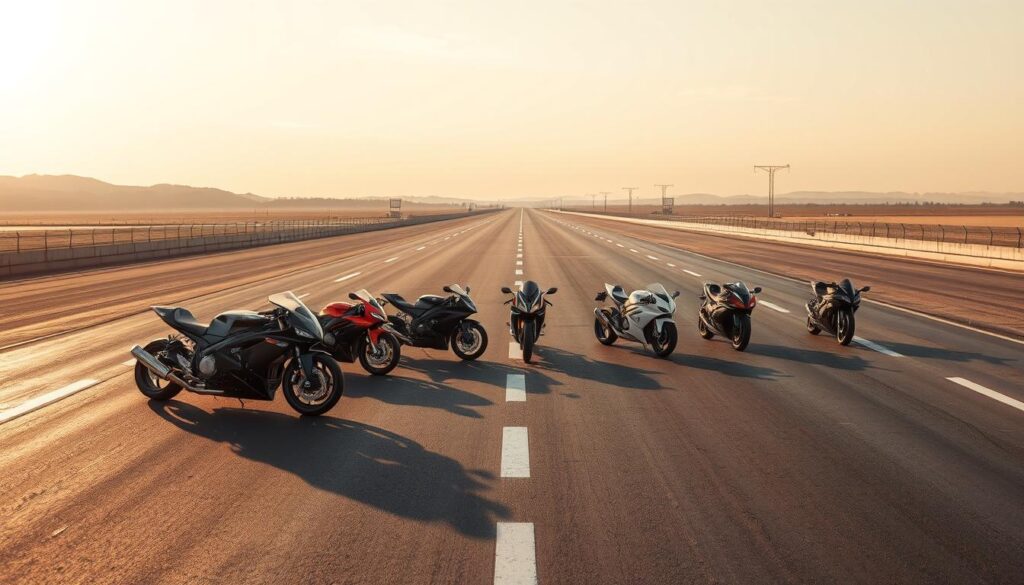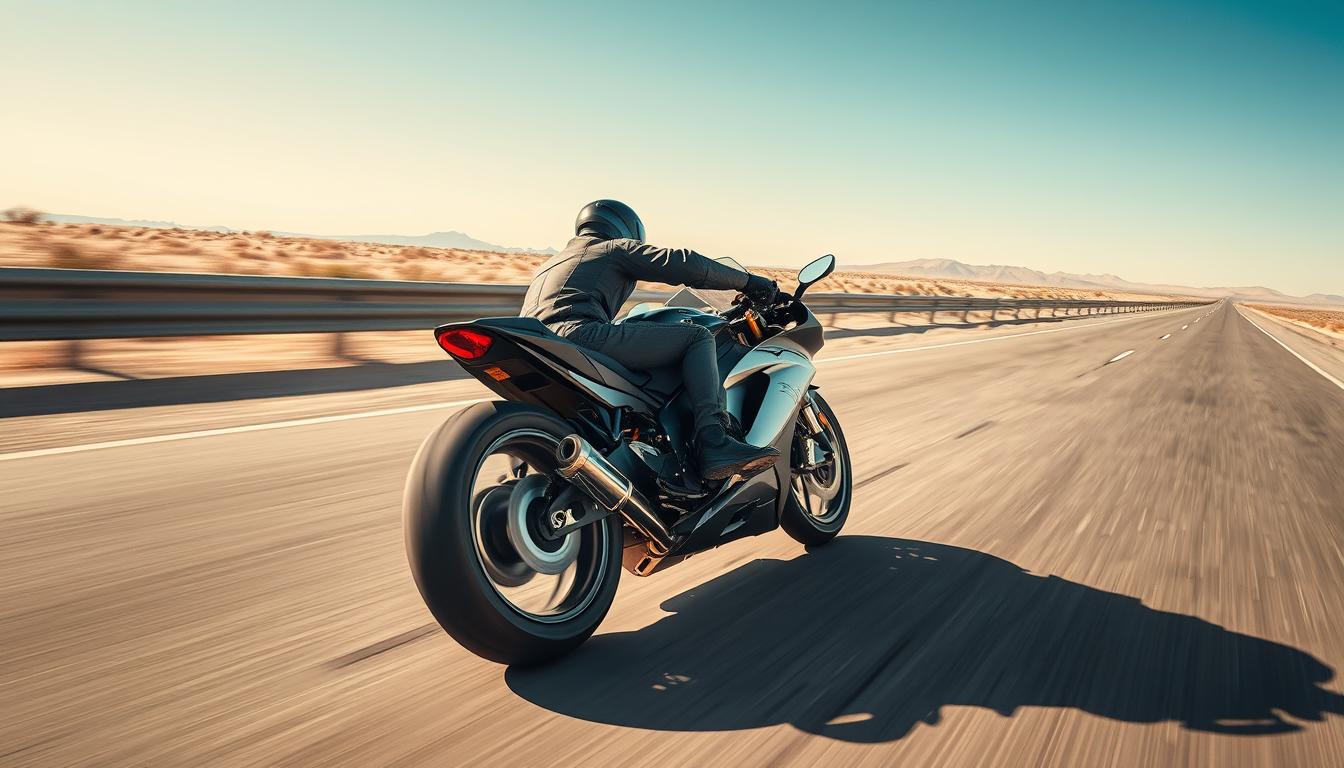The roar of an engine. The wind rushing past. The thrill of speed is more than a number—it’s an experience. This is what makes the fastest street legal motorcycle so special. These bikes blend power, precision, and cutting-edge technology to deliver performance that’s both thrilling and street-legal.”
Street legal motorcycles represent the pinnacle of engineering, with manufacturers constantly pushing the boundaries of speed and design. From the iconic Brough Superior SS100 of 1925 to the modern superbikes, each one showcases our relentless pursuit of velocity.
For motorcycle enthusiasts, it’s not just about going fast—it’s about appreciating the exceptional engineering that transforms raw power into controlled, high-speed rides. Each bike plays a part in the ongoing evolution of motorcycle innovation, as engineers continue to redefine what’s possible on the road.
Key Takeaways
- Street legal motorcycles represent the ultimate combination of performance and road-legal engineering
- Speed records have dramatically evolved from 100 mph to nearly 200 mph
- Technological innovations continue to push motorcycle performance boundaries
- Modern superbikes blend incredible speed with sophisticated safety features
- Each motorcycle tells a unique story of engineering excellence
Understanding Speed Limitations and the Gentleman’s Agreement for the Fastest Street Legal Motorcycle
In the world of fastest bikes, motorcycle makers once followed a special rule. This “Gentleman’s Agreement” was a secret deal to limit top speeds. It was a big change in how bikes were made.

The 300 km/h Speed Limit Protocol
By the early 2000s, big bike makers agreed on a speed cap. They decided no bike could go over 300 km/h (186 mph). This was a rule they made for themselves.
- Japanese manufacturers led the speed limitation initiative
- Top models like Kawasaki ZX-11 and Honda CBR1000XX were electronically restricted
- Bikes like Suzuki Hayabusa reached speeds of 194 mph
Impact on Motorcycle Manufacturing
The Gentleman’s Agreement changed how bikes were designed and built. Makers focused on:
- Advanced aerodynamics
- Enhanced electronic control systems
- Improved power-to-weight ratios
Breaking the Agreement: Modern Developments
Today, bike makers are pushing past old speed limits. Brands like Kawasaki and BMW are making bikes that go faster than before. This shows how bike tech has grown.
“Speed is not just about numbers, it’s about pushing technological boundaries.” – Anonymous Motorcycle Engineer
This shift from strict limits to new tech is a big deal in bike history.
Evolution of Speed Records in Fastest Street Legal Motorcycles

The quest for speed has driven motorcycle engineering since its earliest days. When humans first harnessed gasoline power, they immediately began pushing the boundaries of what was possible. The journey of the fastest production motorcycle is a testament to human ingenuity and mechanical innovation.
Early milestones in motorcycle speed began with legendary machines that captured riders’ imaginations. The Brough Superior SS100, introduced in 1925, was a groundbreaking motorcycle that first broke the 100 mph barrier. This marked a significant moment in motorcycle history, proving that street-legal bikes could achieve remarkable velocities.
“Speed was not just a measurement, but a challenge to be conquered.” – Motorcycle Engineering Pioneer
Key speed milestones in fastest production motorcycle development include:
- 1948: Vincent Black Shadow reaches 125 mph
- 1997: Honda CBR1100XX Super Blackbird hits 178.5 mph
- 2009: BMW S 1000 RR breaks 188 mph speed limit
- 2024: Kawasaki Ninja H2R achieves 250 mph
The technological progression shows how manufacturers have kept improving engines, aerodynamics, and materials. This led to faster street-legal motorcycles. Each new generation brought big leaps in power, weight reduction, and performance.
By breaking traditional speed limits, motorcycle makers turned these machines into high-performance engineering marvels. The evolution of speed in street-legal motorcycles is a remarkable journey of human creativity and technological advancement.
Fastest Street Legal Motorcycle: Current Record Holders
Several incredible machines are pushing the limits of speed and engineering. Street legal motorcycles have become true speed demons. They capture the imagination of riders and enthusiasts worldwide.
Let’s explore the most remarkable speed champions. They have set incredible records while remaining street legal:
MTT Y2K Turbine Superbike: The Unrivaled Speed Demon
The MTT Y2K Turbine Superbike is a marvel in high-speed motorcycles. It has an official top speed of 227 mph. This machine is powered by a turbine engine and can potentially reach speeds over 250 mph.
Lightning LS-218: Electric Speed Revolution
The Lightning LS-218 breaks traditional speed barriers. It achieves an impressive 218 mph. This electric superbike shows that alternative power sources can deliver exceptional performance.
Suzuki Hayabusa: The Legendary Speed Icon
The first-generation Suzuki Hayabusa is a legendary street legal motorcycle. It reaches speeds up to 194 mph. This bike revolutionized motorcycle design and set new standards for speed and performance.
| Motorcycle | Top Speed | Unique Feature |
|---|---|---|
| MTT Y2K Turbine Superbike | 227 mph | Turbine Engine |
| Lightning LS-218 | 218 mph | Electric Powertrain |
| Suzuki Hayabusa | 194 mph | Aerodynamic Design |
“Speed is not just about velocity, it’s about pushing the boundaries of what’s possible.” – Anonymous Motorcycle Engineer
Each of these motorcycles shows a unique approach to achieving extraordinary speed. They remain street legal and inspire motorcycle enthusiasts and engineers.
Japanese Superbike Speed Champions: The Fastest Street Legal Motorcycles
Japanese makers lead in the race for the fastest motorcycle. The “Big Four” – Honda, Kawasaki, Suzuki, and Yamaha – have changed motorcycle engineering. Their superbikes are a marvel of speed and performance.
Kawasaki is a true speed champion. The Kawasaki Ninja H2R is a masterpiece, hitting 386 kmph and even reaching 400 kmph unofficially. It shows the ultimate goal of speed.
“Speed is not just about numbers, it’s about pushing the limits of human and machine potential.” – Motorcycle Engineering Expert
Notable Japanese Speed Machines
- Kawasaki Ninja ZX-14R: Top speed of 299 kmph
- Honda CBR1000RR-R Fireblade SP: 186 MPH (limited)
- Yamaha YZF-R1M: 186 MPH (limited)
Since 1999, Japanese bikes have a speed limit of 300 kph (186 mph). But their engineering still amazes fans everywhere.
Performance Highlights
| Motorcycle | Top Speed | Engine Displacement | Max Power |
|---|---|---|---|
| Kawasaki Ninja H2 | 200 MPH | 998 cc | 228 HP |
| Honda CBR1000RR-R | 186 MPH | 999.9 cc | 215 HP |
| Yamaha YZF-R1M | 186 MPH | 998 cc | 198 HP |
Japanese motorcycle makers keep pushing the limits of speed. They show that innovation has no limits.
European Speed Demons: Italian and German Engineering for the Fastest Street Legal Motorcycles
European motorcycle makers have always aimed for the top in speed and performance. They’ve made some of the fastest bikes in the world. Their skill in engineering has changed the game, mixing precision, new ideas, and racing history.
Looking at the fastest bikes, European brands really stand out. They’ve made amazing strides in speed and design.
Ducati’s Velocity Ventures
Ducati is a big name in motorcycle engineering, thanks to its racing success. The brand’s focus on speed is clear in bikes like the Desmosedici RR. It’s a rare MotoGP replica bike.
- Limited production runs
- Direct racing technology transfer
- Exceptional performance engineering
BMW’s Speed Innovation
German engineering offers a unique take on motorcycle speed. BMW has developed new tech that boosts performance while keeping things precise and reliable.
“Speed is not just about raw power, but intelligent design” – BMW Motorcycle Engineering Team
MV Agusta’s Racing Heritage
MV Agusta is the top of Italian motorcycle making. Their bikes are more than just vehicles; they’re art that shows speed and beauty. The brand’s racing history still drives their quest for the fastest bike.
- Rich motorsport history
- Innovative design philosophy
- Commitment to performance excellence
Technology Behind Speed: Engineering Innovations in Fastest Street Legal Motorcycles
Creating the fastest bike is all about engineering. Modern engineering has changed how we design, develop, and make high-speed motorcycles.
Some key tech advancements for faster bikes include:
- Advanced aerodynamic design
- Lightweight materials like carbon fiber
- Precision electronic control systems
- High-performance turbocharged engines
Companies like Kawasaki and Suzuki have made incredible strides. The Kawasaki Ninja H2R is a top example, with 310 horsepower and speeds up to 249 mph.
“Speed is not just about power, but about intelligent engineering design.” – Motorcycle Engineering Expert
New features like superchargers and advanced rider aids have changed bike performance. Today’s fastest bikes use complex models and new materials to hit record speeds.
Racing tests new tech that makes its way to street bikes. This means we get faster and more advanced bikes for everyday riding.
- 3D metal printing enables unique design possibilities
- Electronic stability control enhances rider safety
- Advanced battery technologies improve electric motorcycle performance
The quest for speed keeps pushing motorcycle engineering to new heights.
Safety Features in High-Speed Motorcycles: Keeping the Fastest Street Legal Motorcycles Safe
When we ride the fastest production motorcycle, safety is key. Manufacturers have created advanced tech to keep riders safe while still offering great performance. They’ve found a way to balance speed with smart safety features that can save lives.
Riding a motorcycle is risky. Motorcyclists are 24 times more likely to die in an accident than car drivers. To fight these dangers, new safety systems have been developed to protect riders.
Advanced Braking Systems
Modern bikes use advanced braking tech to prevent crashes. Anti-lock braking systems (ABS) are a big help. They stop wheels from locking up during sudden stops, which lowers fatality rates.
- ABS reduces fatal accidents by 22%
- Prevents wheel skidding during sudden braking
- Maintains steering control in critical moments
Aerodynamic Developments
Aerodynamics are key in motorcycle safety. The design of the bike helps it stay stable at high speeds. It also cuts down wind resistance, making the bike easier to control.
Electronic Rider Aids
Electronic systems offer unmatched protection for the fastest motorcycle riders. These smart technologies watch for dangers and act fast to protect the rider.
| Safety Technology | Function |
|---|---|
| Traction Control | Prevents wheel spin on slippery surfaces |
| Collision Warning | Detects potential crash risks in real-time |
| Adaptive Headlamps | Adjusts beam angle during cornering |
Safety technologies are changing motorcycle riding from a risky activity to a safer experience.
“The best speed is the speed that gets you home safely” – Motorcycle Safety Experts
Legal Considerations for High-Speed Motorcycles
Understanding the laws for the world’s fastest bike is complex. High-performance motorcycles must follow strict rules. These rules ensure the bike is safe for the public and meets performance standards.
Important legal points for bike lovers include:
- Licensing needs with special motorcycle endorsements
- Vehicle registration and check-ups
- Compliance with safety gear
- Rules for noise and emissions
Getting a motorcycle license is tough. In the U.S., some states have flexible helmet laws. Riders must pass tough written and practical tests. Motorcycles are only 3% of all vehicles but cause 14% of all traffic deaths, making following the law key.
“Safety isn’t just about speed—it’s about responsible riding and understanding legal boundaries.”
Street-legal changes often involve:
- Working lights
- A working horn
- A visible license plate
- Legal exhaust systems
Up to 25% of motorcyclists get fines each year for not following local rules. Companies like Ducati design their bikes to meet these laws while still being fast.
Knowing these legal details helps riders stay within the law. This way, they can enjoy their bikes safely and responsibly.
Future of Street Legal Speed Machines
The world of the fastest motorcycles is changing fast. Electric bikes are making big leaps, going beyond what old engines could do. The Stark Future Varg EX electric motorcycle shows us what’s coming.
Big changes in motorcycle tech include:
- Advanced electric powertrains with amazing torque
- Smart battery systems that charge quickly
- Lighter bikes with more power
- High-tech rider aids
The Stark Future Varg EX is a top example of what’s next. It shows how electric tech can make bikes faster and better:
| Feature | Specification |
|---|---|
| Power Output | 60-80 HP |
| Torque | 764 ft-lbs |
| Weight | 265 lbs |
| Battery Capacity | 7.2 kWh |
As tech gets better, we’ll see even more amazing bikes. The future holds bikes that are faster, greener, and smarter.
“The next generation of motorcycles will redefine speed and sustainability.” – Motorcycle Technology Experts
Electric bikes are not just getting faster. They’re also changing how we ride. The most fastest motorcycle in the world will soon be about more than just speed. It will be about being efficient, smart, and kind to the planet.
Conclusion
The quest for speed in motorcycle engineering is a remarkable journey of human innovation. The Lightning LS-218 hit 218 MPH, while the MTT 420RR reached an amazing 273 MPH. This shows how manufacturers keep pushing the limits to make the fastest motorcycle in the world.
Your love for high-performance motorcycles pushes makers to create better machines. Now, electric and traditional fuel models compete fiercely. The Damon Hypersport Premier, for example, is an electric bike that hits 200 MPH with fast acceleration.
The future of speed motorcycles is bright. Kawasaki, Ducati, and electric bike makers are setting new speed records and improving safety. As technology advances, you can look forward to even more thrilling rides from the fastest motorcycle in the world.
These incredible bikes are more than just ways to get from point A to point B. They show human creativity, technological skill, and the drive to go beyond what’s possible. Whether they run on electricity or gasoline, these speed champions inspire riders all over the world.
FAQ
What is the fastest street legal motorcycle in the world?
The MTT Y2K Turbine Superbike is the fastest street legal motorcycle, reaching 227 mph. The Lightning LS-218 also stands out, hitting 218 mph while still being street legal.
How do manufacturers balance speed with street legal requirements?
To meet legal standards, manufacturers add safety features and electronic aids. They use advanced engineering for high performance and safety.
What was the “gentleman’s agreement” in motorcycle manufacturing?
The gentleman’s agreement was a self-imposed rule to limit speeds to 186 mph. It aimed to prevent a speed race and ensure safety.
Are electric motorcycles competitive in speed records?
Yes, electric bikes like the Lightning LS-218 are very fast. They challenge traditional bikes and show electric powertrains can be very speedy.
Which countries lead in high-speed motorcycle production?
Japan and Italy are leaders in high-speed motorcycles. Brands like Suzuki, Kawasaki, and Ducati have set high standards for speed and performance.
What safety features protect riders on high-speed motorcycles?
High-speed bikes have advanced safety tech. This includes traction control, ABS, electronic stability control, and aerodynamic designs. These features ensure safety at high speeds.
How have motorcycle speeds evolved over the decades?
Motorcycle speeds have grown a lot since the 1925 Brough Superior SS100. Now, modern superbikes can go over 220 mph. Advances in materials and technology have made this possible.
What challenges do manufacturers face in creating faster motorcycles?
Manufacturers face many challenges. These include designing for aerodynamics, improving engine efficiency, and reducing weight. They also need to meet safety regulations and keep bikes street legal.
Are there legal restrictions on motorcycle top speeds?
No global speed limits exist for motorcycles. But, countries have their own rules on modifications, licensing, and road use. These can affect high-speed riding.
What is the future of high-speed motorcycle technology?
The future is bright with new tech like electric powertrains and lightweight materials. Improved aerodynamics and electronic systems will also boost speed and performance.


1 thought on “Fastest Street Legal Motorcycle: Models That Break Speed Limits”